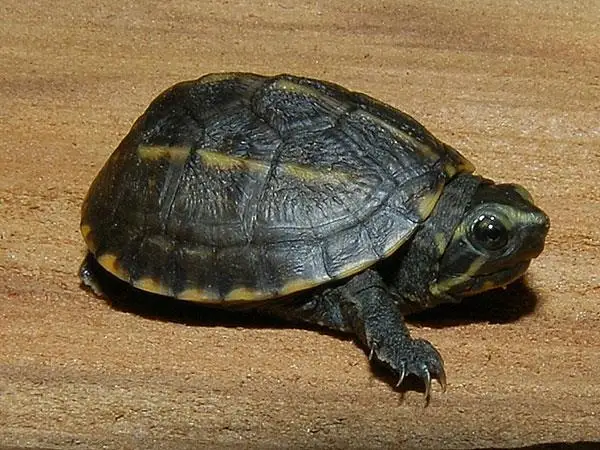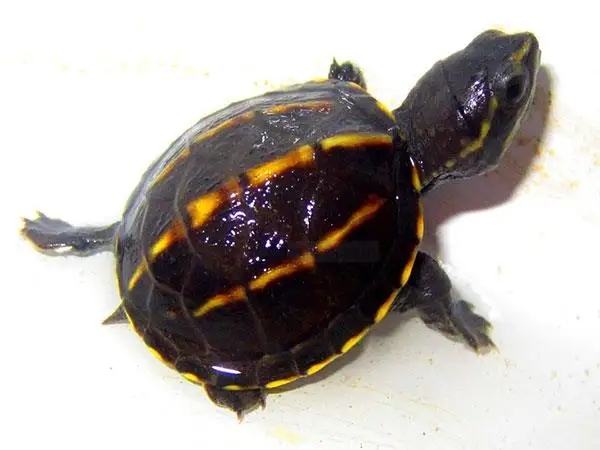Variety Overview
English Name: Striped Mud Turtle
Also Known As: Fruit Kernel Turtle, Fruit Kernel Mud Turtle, Three-lined Egg Turtle,Three-lined Moving Chest Turtle
Origin: Florida, USA
Price Range: about $70~$420 USD
Size: Around 12 cm (4.7 inches)
Lifespan: 30 to 55 years
Morphological Features and Identification
The Striped Mud Turtle (Kinosternon baurii) is one of the smaller species among mud turtles. Its carapace features three distinctive stripes that serve as key identifiers. Wild turtles typically have darker shells, while those raised in captivity tend to have lighter ones due to varying levels of sunlight exposure. Adult males can be identified by their slightly concave plastrons, hook-shaped thicker tails compared to females, and inward-curving claws. Juvenile and adult female turtles have flatter plastrons and shorter tails.
The turtle’s carapace is broad and flat, with its highest and widest points located towards the rear center. Unlike adults, juvenile Striped Mud Turtles have a central vertebral ridge at birth which disappears as they mature. The first vertebral scute is generally longer and extends forward to meet the first two marginal scutes. Vertebral scutes from the second to fifth are wider than they are long, giving them a flattened appearance that may form a shallow groove along the back’s centerline. The tenth marginal scute stands out as being significantly taller than others.
Carapace colors range from black to brownish tones, with some appearing nearly translucent enough to reveal skeletal structures beneath. Three light yellow or cream-colored stripes run longitudinally along their backs; these stripes may fade or blur over time.

Maintenance Tips
Similar to most aquatic turtles, the Striped Mud Turtle needs sunlight, clean water, and appropriate temperatures. It mainly eats meat (unlike the Yellow-headed turtle which is herbivorous). When keeping them in captivity, ensure a stable temperature environment with a basking platform.
Basking Requirements
Striped Mud Turtles need to come ashore regularly. Daily observations show they prefer morning and evening sunlight and often sleep on land at night. Providing a safe piece of land will result in them spending more time there. Ideally, offer a platform where they can bask in the sun; if sunlight isn’t available, still provide some land for them.
Water Depth Arrangement
The maximum water depth should generally be around 20cm. While Striped Mud Turtles are decent swimmers, their semi-webbed toes suggest they aren’t particularly suited for deep-water habitats.
Temperature Requirements
Striped Mud Turtles are found from tropical Florida to northern New York State in North America—comparable to China’s range from Sanya to Dalian—indicating strong adaptability. Typically, similar care guidelines as for Yellow-throated Turtles apply: they start feeding above 18°C and enter summer dormancy above 32°C. The ideal temperature range is between 23-30°C.

Feeding Techniques
The striped-neck terrapin has an omnivorous diet and can consume both meat and plant seeds. This makes them relatively easy to care for under artificial breeding conditions since they are not picky eaters.
Diet in the Wild
In their natural habitat, striped-neck terrapins are primarily carnivorous but will occasionally eat plants such as palm seeds, leaves, petals, and various types of algae. Their animal-based diet includes snails, insects, mollusks, crustaceans, amphibians, and dead fish. They are easily caught using hooks baited with liver, grasshoppers, worms, or dough. In the wild, they act as scavengers; on land, they will dig into livestock feces to eat undigested forage or search for insects.
Diet in Captivity
When kept in captivity, striped-neck terrapins will eat almost anything—commercial turtle food, fish, shrimp, earthworms—basically anything that water turtles enjoy. A mix of high-quality three-in-one turtle food + Vitality Water Turtle Food + Koi Feed + Gold Turtle Food can be used for feeding. When the temperature is appropriate, feeding every two to three days is sufficient. These creatures are quite voracious; once they get used to being fed by you regularly, they will amusingly chase after you for food whenever you come near.
